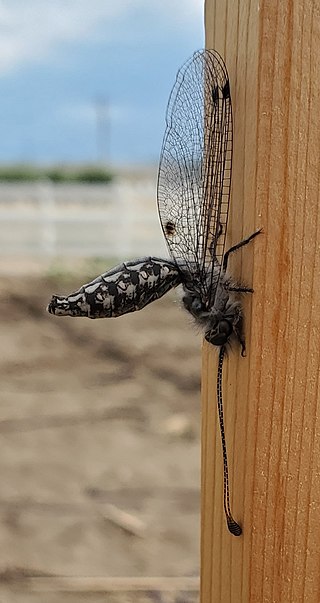
The insect order Neuroptera, or net-winged insects, includes the lacewings, mantidflies, antlions, and their relatives. The order consists of some 6,000 species. Neuroptera is grouped together with the Megaloptera and Raphidioptera (snakeflies) in the unranked taxon Neuropterida.

The antlions are a group of about 2,000 species of insect in the neuropteran family Myrmeleontidae. They are known for the predatory habits of their larvae, which mostly dig pits to trap passing ants or other prey. In North America, the larvae are sometimes referred to as doodlebugs because of the marks they leave in the sand. The adult insects are less well known due to their relatively short lifespans in comparison with the larvae. Adults, sometimes known as antlion lacewings, mostly fly at dusk or just after dark and may be mistakenly identified as dragonflies or damselflies.

Ascalaphidae is a family of insects in the order Neuroptera, commonly called owlflies; there are some 450 extant species. They are fast-flying crepuscular or diurnal predators of other flying insects, and have large bulging eyes and strongly knobbed antennae. The larvae are ambush predators; some of them make use of self-decoration camouflage.

Hemerobiidae is a family of Neuropteran insects commonly known as brown lacewings, comprising about 500 species in 28 genera. Most are yellow to dark brown, but some species are green. They are small; most have forewings 4–10 mm long. These insects differ from the somewhat similar Chrysopidae not only by the usual coloring but also by the wing venation: hemerobiids differ from chrysopids in having numerous long veins and forked costal cross veins. Some genera are widespread, but most are restricted to a single biogeographical realm. Some species have reduced wings to the degree that they are flightless. Imagines (adults) of subfamily Drepanepteryginae mimic dead leaves. Hemerobiid larvae are usually less hairy than chrysopid larvae.

Nymphidae, sometimes called split-footed lacewings, are a family of winged insects of the order Neuroptera. There are 35 extant species native to Australia and New Guinea.

Ascalaphinae is the type subfamily of the neuropteran owlfly family. Most species are found in the tropics. Their characteristic apomorphy, shared with the Ululodinae, is the ridge which divides each of their large compound eyes; both groups are thus sometimes known as split-eyed owlflies.

Nemoptera is a Palearctic genus of insects of the spoonwing family, Nemopteridae. All species are diurnal with an exclusively floral diet, preferring to fly in open spaces in full sunshine while visiting flowers. They can be recognized by their very long hind wing prolongations.

Libelloides coccajus, the "owly sulphur", is an owlfly species belonging to the family Ascalaphidae, subfamily Ascalaphinae.

Palparini is an antlion tribe in the subfamily Palparinae.

Myrmeleontoidea is a neuropteran superfamily in the clade Myrmeleontiformia. Engel, Winteron, and Breitkreuz (2018) included the following families:

Myrmeleontiformia is an insect clade in the order Neuroptera, and which was historically treated as a suborder. The phylogeny of the Neuroptera has been explored using mitochondrial DNA sequences, and while issues remain for the order as a whole, such as "Hemerobiiformia" being paraphyletic, Myrmeleontiformia is generally agreed to be monophyletic, with one study giving the following cladogram:

Acanthaclisini is a tribe in the antlion subfamily Myrmeleontinae.
Cordulecerus is a genus of owlflies, neuropteran insects in the subfamily Ascalaphinae. Species are found in Central and South America.

Ululodes is a genus of owlflies in the tribe Ululodini. There are at least 27 described species in Ululodes.
Ascaloptynx is a genus of owlflies in the family Ascalaphidae. There are at least two described species in Ascaloptynx.

Megalomus is a genus of brown lacewings in the family Hemerobiidae. There are more than 40 described species in Megalomus.

Libelloides longicornis, common name black yellow owlfly, is an owlfly species belonging to the family Ascalaphidae, subfamily Ascalaphinae.

Ascalaphus is a genus of owlfly belonging to the tribe Ascalaphini. The species of this genus are found in Africa and Asia.

Libelloides macaronius is a day-flying owlfly species of Europe and Asia. The genus belongs to the family Ascalaphidae, subfamily Ascalaphinae.

Ululodinae is a subfamily or tribe of owlflies. Both they and the Ascalaphinae are sometimes known as split-eyed owlflies due to the characteristic ridge that bisects their compound eyes.
Fischer, K., Hölzel, H., Kral, K. (2006) Divided and undivided compound eyes in Ascalaphidae (Insecta, Neuroptera) and their functional and phylogenetic significance. Journal of Zoological Systematics and Evolutionary Research44, 285–289.
Kral, K. (2002) Ultraviolet vision in European owlflies (Neuroptera: Ascalaphidae): a critical review. European Journal of Entomology99: 1–4.















